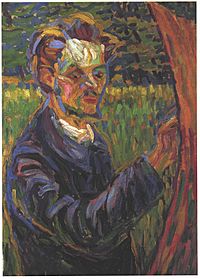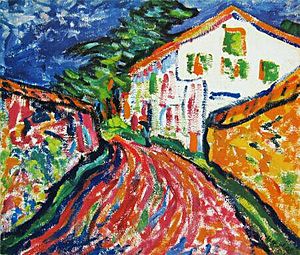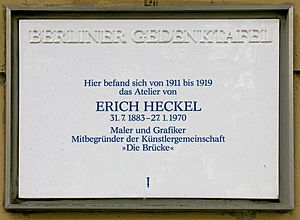Erich Heckel facts for kids
Quick facts for kids
Erich Heckel
|
|
|---|---|

Heckel painting at the easel – portrait by Ernst Ludwig Kirchner
|
|
| Born | 31 July 1883 |
| Died | 27 January 1970 (aged 86) |
| Education | Königliche Technische Hochschule |
| Known for | Painting, woodcuts/printmaking |
| Style | Expressionism |
| Movement | Die Brücke |
Erich Heckel (born 31 July 1883 – died 27 January 1970) was a German painter and printmaker. He was one of the artists who started the famous group called Die Brücke ("The Bridge"). This group was active from 1905 to 1913. Heckel's artwork was even shown in the art competitions at the 1928 Summer Olympics and the 1932 Summer Olympics.
Contents
Early Life and the Brücke Group
Erich Heckel was born in Döbeln, a town in Saxony. His father worked as a railway engineer. From 1897 to 1904, Heckel went to school in Chemnitz. Later, he began studying architecture in Dresden.
While studying architecture, Heckel met other students who loved art. These friends were Ernst Ludwig Kirchner, Karl Schmidt-Rottluff, and Fritz Bleyl. They all felt that studying architecture was a way to please their parents. Their parents might not have supported them if they had wanted to study art right away.
In 1905, Heckel and his friends decided to form an art group. They called it Die Brücke, which means "The Bridge." Heckel became the group's secretary and treasurer. He worked as a draughtsman (someone who draws plans) for an architect named Wilhelm Kreis. He used this job to help Die Brücke. For example, he convinced a lamp company to let the group display their art in an exhibition room. In July 1907, Heckel left his job to become a full-time artist.
Artistic Style and Ideas
As a member of Die Brücke, Heckel helped the group connect with other artists. One important connection was with Franz Marc, an artist from Munich. This helped Die Brücke become more well-known. Their group was even mentioned in the almanac of Franz Marc's own art group, the Blaue Reiter.
Die Brücke artists, including Heckel, really admired the work of Edvard Munch. They wanted to create a "bridge" between older German painting styles and a new, modern style called Expressionism. Expressionism focuses on showing feelings and emotions through art.
The four founding members of Die Brücke often used printmaking to create their art. Printmaking, especially woodcuts, was a fast and cheap way to make art that many people could afford.
The artists of Die Brücke were also inspired by Primitive art. This means art from cultures outside of Europe, like African sculptures. Heckel's brother showed the group some African sculptures. The artists felt that this kind of art had a strong, powerful feeling. They found new ways to express themselves through these "barbaric figures."
Life During and After the World Wars
In December 1911, Heckel moved from Dresden to Berlin. The Die Brücke group officially broke up in 1913.
When World War I started in 1914, Heckel wanted to join the army. However, he was considered too old. Instead, he joined the Red Cross in March 1915. He worked as a medical orderly on a hospital train in Flanders. He helped care for wounded soldiers. This hospital train was a special place. It had many artists working as orderlies, including Heckel. They painted, made woodcuts, and discussed art and poetry. Heckel even became friends with the famous artist James Ensor.
After the war, between 1922 and 1924, Heckel painted a special room in the Angermuseum. This room is now called the Heckelraum. His paintings there are titled Lebenstufen, which means Stages in Life. These murals are considered very important examples of German Expressionism wall paintings.
Sadly, in 1937, the Nazi Party declared Heckel's work "degenerate" (meaning bad or harmful). They stopped him from showing his art in public. More than 700 of his artworks were taken from German museums. By 1944, all of his woodcut blocks and print plates were destroyed.
After World War II, Heckel lived near Lake Constance. He taught at the Karlsruhe Academy until 1955. He continued to paint until he passed away in Radolfzell in 1970.
Legacy and Impact
Erich Heckel was a very productive artist, especially with printmaking. He created 465 woodcuts, 375 etchings, and 400 lithographs. More than 200 of these, mostly etchings, were made in the last seven years of his life.
A large exhibition of his work, called Erich Heckel – His Work in the 1920s, was held from October 2004 to February 2005 at the Brücke Museum in Berlin.
In 2000, one of Heckel's paintings, Dangaster Dorflandschaft (Dangast village landscape) from 1909, was sold for a lot of money at an auction in London.
Interestingly, the famous musician David Bowie used Heckel's painting Roquairol as inspiration for the cover of his 1977 album "Heroes".
See also
 In Spanish: Erich Heckel para niños
In Spanish: Erich Heckel para niños



